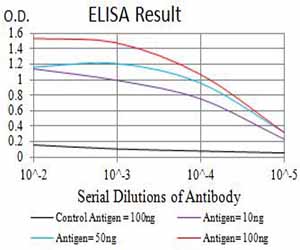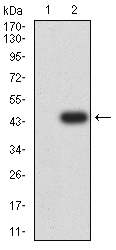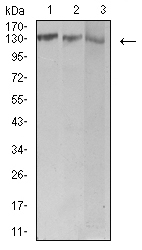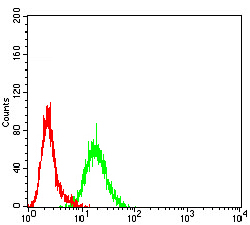BCR
Purified Mouse Monoclonal Antibody
- 产品详情
- 实验流程
Application
| WB, IHC, ICC, E |
|---|---|
| Primary Accession | P11274 |
| Reactivity | Human |
| Host | Mouse |
| Clonality | Monoclonal |
| Clone Names | 1E11G12 |
| Isotype | Mouse IgG1 |
| Calculated MW | 142819 Da |
| Immunogen | Purified recombinant fragment of human BCR (AA: 139-280) expressed in E. Coli. |
| Formulation | Purified antibody in PBS with 0.05% sodium azide |
| Gene ID | 613 |
|---|---|
| Other Names | ALL; CML; PHL; BCR1; D22S11; D22S662 |
| Dilution | WB~~ 1/500 - 1/2000 IHC~~1:100~500 ICC~~N/A E~~ 1/10000 |
| Storage | Maintain refrigerated at 2-8°C for up to 6 months. For long term storage store at -20°C in small aliquots to prevent freeze-thaw cycles. |
| Precautions | BCR is for research use only and not for use in diagnostic or therapeutic procedures. |
| Name | BCR (HGNC:1014) |
|---|---|
| Synonyms | BCR1, D22S11 |
| Function | Protein with a unique structure having two opposing regulatory activities toward small GTP-binding proteins. The C-terminus is a GTPase-activating protein (GAP) domain which stimulates GTP hydrolysis by RAC1, RAC2 and CDC42. Accelerates the intrinsic rate of GTP hydrolysis of RAC1 or CDC42, leading to down-regulation of the active GTP-bound form (PubMed:17116687, PubMed:1903516, PubMed:7479768). The central Dbl homology (DH) domain functions as guanine nucleotide exchange factor (GEF) that modulates the GTPases CDC42, RHOA and RAC1. Promotes the conversion of CDC42, RHOA and RAC1 from the GDP-bound to the GTP-bound form (PubMed:23940119, PubMed:7479768). The amino terminus contains an intrinsic kinase activity (PubMed:1657398). Functions as an important negative regulator of neuronal RAC1 activity (By similarity). Regulates macrophage functions such as CSF1-directed motility and phagocytosis through the modulation of RAC1 activity (PubMed:17116687). Plays a major role as a RHOA GEF in keratinocytes being involved in focal adhesion formation and keratinocyte differentiation (PubMed:23940119). |
| Cellular Location | Postsynaptic density {ECO:0000250|UniProtKB:Q6PAJ1}. Cell projection, dendritic spine {ECO:0000250|UniProtKB:Q6PAJ1}. Cell projection, axon {ECO:0000250|UniProtKB:Q6PAJ1}. Synapse {ECO:0000250|UniProtKB:F1LXF1} |
Research Areas
For Research Use Only. Not For Use In Diagnostic Procedures.
Application Protocols
Provided below are standard protocols that you may find useful for product applications.
REFERENCES
1.Asian Pac J Cancer Prev. 2014;15(22):9961-6.2.Asian Pac J Cancer Prev. 2014;15(12):4773-80.
终于等到您。ABCEPTA(百远生物)抗体产品。
点击下方“我要评价 ”按钮提交您的反馈信息,您的反馈和评价是我们最宝贵的财富之一,
我们将在1-3个工作日内处理您的反馈信息。
如有疑问,联系:0512-88856768 tech-china@abcepta.com.























 癌症的基本特征包括细胞增殖、血管生成、迁移、凋亡逃避机制和细胞永生等。找到癌症发生过程中这些通路的关键标记物和对应的抗体用于检测至关重要。
癌症的基本特征包括细胞增殖、血管生成、迁移、凋亡逃避机制和细胞永生等。找到癌症发生过程中这些通路的关键标记物和对应的抗体用于检测至关重要。 为您推荐一个泛素化位点预测神器——泛素化分析工具,可以为您的蛋白的泛素化位点作出预测和评分。
为您推荐一个泛素化位点预测神器——泛素化分析工具,可以为您的蛋白的泛素化位点作出预测和评分。 细胞自噬受体图形绘图工具为你的蛋白的细胞受体结合位点作出预测和评分,识别结合到自噬通路中的蛋白是非常重要的,便于让我们理解自噬在正常生理、病理过程中的作用,如发育、细胞分化、神经退化性疾病、压力条件下、感染和癌症。
细胞自噬受体图形绘图工具为你的蛋白的细胞受体结合位点作出预测和评分,识别结合到自噬通路中的蛋白是非常重要的,便于让我们理解自噬在正常生理、病理过程中的作用,如发育、细胞分化、神经退化性疾病、压力条件下、感染和癌症。










